Author: Arthur Hayes, founder of BitMEX; Translator: 0xxz@黄金财经
Wharton School promotes capitalism and American exceptionalism. Students from all over the world are excited, and professors tout the benefits of free-market capitalism and the "rules-based" American order of governance, which is enforced by the tip of a Tomahawk cruise missile. But if you, like me, entered the workplace in September 2008, you will soon find that most of your education is nonsense. The reality is that this system is not truly meritocracy - on the contrary, the companies that can benefit the most from the government are the most financially successful in the end. Capitalism is for the poor.
I learned my first lesson about real capitalism (or what I now call corporate socialism) after seeing which large investment banks prospered and which faltered after the global financial crisis in 2008. After the bankruptcy of Lehman Brothers, American banks all received government rescues through direct capital injections. Although European banks received covert financial support from the Federal Reserve (Fed), they did not receive government recapitalization or forced mergers (paid for by central bank loan guarantees) until 2011. So when my class of analysts at Deutsche Bank received our first full-year bonuses for the 2009 calendar year in February 2010, we were left behind by our friends working at Bank of America (who pressed F9).
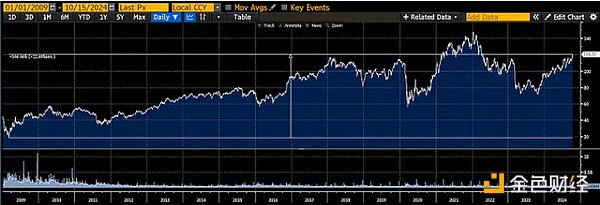
This is the KBW Bank Index, which includes the largest publicly traded commercial banks in the United States. The index has rebounded more than 500% from its post-global financial crisis lows in March 2009.
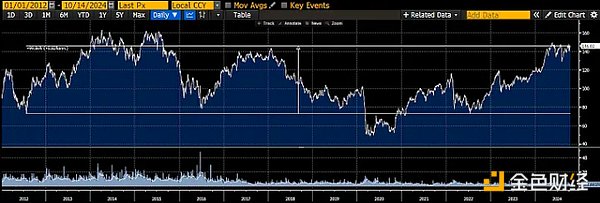
This is the Euro Stoxx Bank Index, which includes Europe's largest banks. The index has rebounded 100% from its post-crisis lows in 2011 alone.
No matter what the political pundits say, corporate socialism is more profitable and more prevalent in the United States than in Europe.
Remember, kids, privatizing gains and socializing losses is a recipe for big bonuses.
Given China's claims that its economic system is different and superior to the West, you might think they might have different policies to solve its economic problems. Wrong. Ordinary people.
To understand the huge changes China is going through, one must first understand the recent financial crises in the other three major economies: the United States, Japan, and the European Union. These economies have all suffered severe financial crises as a result of the bursting of their real estate bubbles.
China can now join the list of economies that have suffered from the bursting of their real estate bubbles. The Chinese central government set the process in motion in 2020 by restricting credit to real estate developers through a policy known as the “Three Red Lines.”
ChatGPT explains the policy:
China’s “Three Red Lines” policy is a regulatory framework introduced in August 2020 to curb excessive borrowing by real estate developers and reduce financial risks in the real estate sector. The policy sets strict thresholds for three key financial indicators: debt-to-asset ratio (excluding prepayments) below 70%, net gearing (net debt divided by equity) below 100%, and cash-to-short-term debt ratio greater than 1. Depending on how many of these thresholds they violate, developers are categorized and their permitted debt growth is capped accordingly—developers that meet all criteria can add up to 15% more debt per year, while developers that violate all three cannot. By enforcing these “three red lines,” the Chinese government aims to encourage developers to deleverage and strengthen their financial position, thereby promoting financial stability.
Like all the other victims, the Chinese economy then fell into a liquidity trap, or balance sheet recession. Private businesses and households cut back on spending, reduced economic activity, and saved money to repair their balance sheets. When household and corporate demand for credit falls, the standard Keynesian economic prescription—modest fiscal deficits and lowering the price of money through cuts in the central bank’s policy rate—is ineffective. What’s needed to prevent the dreaded deflation is a monetary and fiscal bazooka. How long it takes to go into panic mode depends on a country’s culture. But make no mistake—regardless of its so-called economic “ism,” every country eventually gets a shot of monetary chemotherapy.
I call this palliative care chemotherapy because, while it may cure the deflationary cancer, it ultimately kills the host. The hosts are the lower middle class, who suffer from asset price inflation while the real economy shows no discernible improvement. Like modern oncology, this ultimately ineffective monetary chemotherapy is very profitable for a small group of financial witch doctors, based in New York, London/Paris/Frankfurt, Tokyo, and now possibly Beijing/Shanghai.
Monetary chemotherapy is a two-pronged treatment.
First, the banking system must be recapitalized using public funds. The banks’ balance sheets are always filled with junk real estate loans. The private market will no longer provide any equity capital, which is why the banks’ share prices have plummeted and gone bankrupt. The government must inject new money and change the accounting rules ex post to legitimize the banks’ financial position of lying to the world. For example, Japan allowed its banks to remain accounting solvent by holding real estate assets at purchase cost rather than actual current market value. After the government’s capital injection, the banks can resume expanding their lending, thereby increasing the amount of broad money in the economy. As the amount of bank credit increases, nominal GDP also increases.
Second, the central bank must print money, what is now known as quantitative easing (QE). This is done by buying government debt with printed money. With reliable buyers of debt, the government can afford to do whatever it takes to implement a massive stimulus program. QE also forces reluctant savers back into riskier financial markets. As central banks suck up all the safest interest-bearing government debt, savers replace their "safe" government bonds by speculating in financial markets. These activities are imperative because savers correctly see the inflationary effects of monetary chemotherapy coming. Ultimately, this means buying real estate and stocks again. For those who don't have enough financial assets, they are simply out of luck.
Bankrupt banks are saved because the prices of the financial assets (real estate and stocks) that support their loan books rise. I call this reflation, and it is the opposite of deflation. The government is able to increase stimulus because incomes grow due to rising nominal GDP, which rises due to increased broad money creation led by banks and the ability of banks to issue unlimited amounts of debt (which the central bank ultimately buys with printed money). For those in the business of financial speculation (that’s you, the reader), the link between actual economic performance and asset prices is severed. The stock market is no longer a forward-looking reflection of the economy, but the economy itself. The only thing that matters is monetary policy and the rate of money creation. Sure, if you want to be a stock picker, the specific policies of the government regarding what types of companies are designated to receive capital are important, but the price of Bitcoin and cryptocurrencies is primarily affected by the total money supply. As long as fiat money is being created, Bitcoin will soar. It doesn’t matter who the ultimate beneficiaries are.
The current narrative among financial analysts is that the stimulus announced by China is still not enough to right-size the economy. This is true, but there are clues hidden in recent statements that China is ready to inject monetary chemotherapy to cure its deflationary cancer. This means that Bitcoin will soar in the long run as China revitalizes its banking system and real estate sector. Given that RMB credit creation will rival the total amount of dollars the US has printed in response to COVID in 2020-2021.
To make my case, I will walk through the following:
Why do modern governments inflate huge real estate bubbles?
Analyzing the size of China’s real estate bubble and the reasons for deciding to end it.
Signs point to readiness to revive China’s economy.
How the RMB will fit into Bitcoin.
Social Order
Modern governments are built on broad popular support. In an age when the largest nation-states and their rulers do not rely on organized religion for legitimacy, how can states co-opt ordinary people to support their rule? The simplest way to eliminate the threat of revolution is to tie citizens’ financial net worth to the success of the ruling regime.
The most important financial asset you own—or that you wish you owned—is your primary residence. The human body can only survive within a very narrow temperature range. Fundamentally, our shelter is a temperature-controlled structure that allows us to maintain homeostasis. However, if you are out on the street, you will certainly feel too hot or too cold, which in extreme cases can lead to death.
Forget housing costs - let's say you have saved enough money to buy a house for you and your family. Your biggest concern is who will protect your property rights? Without a government that has the power to legally kill those who oppose domestic rules and regulations, a private army is needed to enforce these rights. What stops a heavily armed neighbor from claiming your land as theirs? When the state is strong and the laws are respected, you don't have to worry about homeless people stealing your belongings. But when the state is weak, you must be prepared to commit violence against those who would deprive you of your property rights. Therefore, if you own property, you naturally trust the government to protect your rights. In return for their protection, you will follow their orders. Ultimately, this means that you will not resist because it will cause you financial losses.
The government's interest is to make as many citizens as possible property owners, thereby tying their financial and physical health to the state. Since energy is expensive and it always takes energy to build buildings, the government works hard to create programs to encourage private ownership of property, usually through various debt-financed programs. Even in China, property rights were one of the first things to be reformed, starting with Deng Xiaoping in the late 1980s and early 1990s.
Let me give a thumbs up to my alma mater. One of the best classes I have ever taken was Housing Policy, taught by former US President Clinton's Deputy Secretary of Housing. I took this class in the first half of 2008, just as the subprime mortgage crisis was unfolding. We learned about the various government programs that were put in place to increase homeownership. The main thing I took away from this class was that housing bubbles always require government support and financing. In the US, the government began to strongly encourage homeownership starting during the Clinton administration (1992-2000), expanding the role of government-sponsored entities (GSEs) such as Fannie Mae and Freddie Mac, starting with the Federal Housing Enterprise Financial Safety and Soundness Act of 1992. GSEs are private companies that are publicly traded, but have the tacit support of the federal government. They underwrite the majority of residential mortgages because they fund the loans, just like the federal government. As a result, Fannie Mae and Freddie Mac are among the most profitable financial services companies. Banks do their job by making risk-free profits on loans, ultimately shifting risk onto the public sector balance sheet. Of course, given these distorted incentives, the Masters of the Universe overreached — but they would never have taken these risks without government support.
Hmm… sounds a lot like how local governments in mainland China are funded. China and the US unite!
Thanks to BCA Research, Ned Davis Research, Gavekal Research for the great charts on the Chinese economy.
Real Estate with Chinese Characteristics
First, let me explain the Chinese economic model. To industrialize quickly, the Chinese government fiscally repressed savers through the state-owned banking system to provide capital cheaply to state-owned industrial enterprises. If the largest users of bank credit are industrial enterprises, then a reasonable interest rate for depositors is a percentage of industrial value added. The percentage of industrial value added refers to the proportion of a country's GDP that is in the industrial sector, and is calculated by dividing the value added generated by all industrial activities by the total GDP.
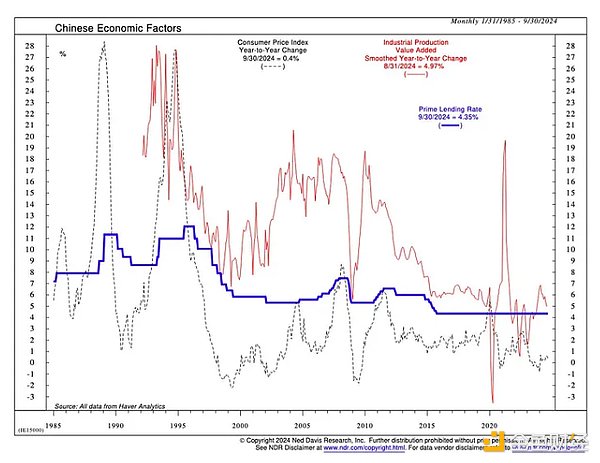 As can be seen, the prime lending rate is always lower than industrial value added. This is because the deposit interest rates paid by state-owned banks to ordinary savers are negligible - see the figure below.
As can be seen, the prime lending rate is always lower than industrial value added. This is because the deposit interest rates paid by state-owned banks to ordinary savers are negligible - see the figure below.
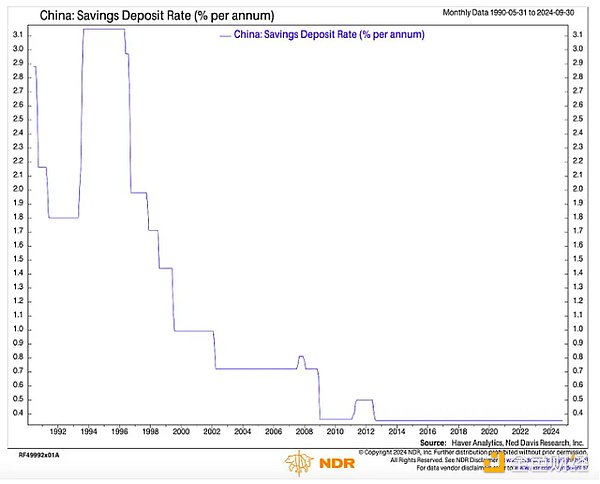 Depositors know they are being treated unfairly, but because the RMB is a restricted currency, depositors cannot invest overseas. To get a better return on their capital, they can invest in local stocks or the property market.
Depositors know they are being treated unfairly, but because the RMB is a restricted currency, depositors cannot invest overseas. To get a better return on their capital, they can invest in local stocks or the property market.
The problem with the stock market is that the best companies are state-owned enterprises. SOEs get the cheapest bank credit and are allowed to engage in monopolistic behavior because they have exclusive licenses to operate in the most profitable industries (telecom, oil and gas, mining, etc.). You might think this means that SOE stocks have performed very well. But SOEs' return on equity (ROE) is not as good.
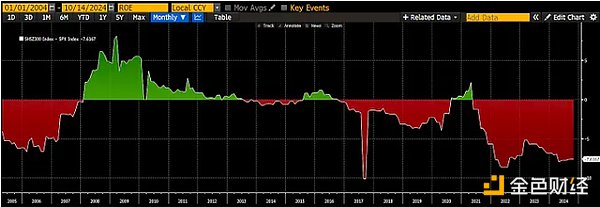
This chart is CSI300 ROE minus S&P 500 ROE. As you can see, Chinese stocks are performing worse than US stocks.
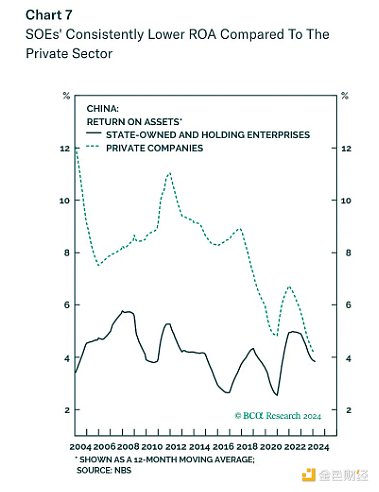 Private enterprises that participate in real competition earn higher returns than state-owned enterprises. However, state-owned enterprises are more represented in major stock market indices.
Private enterprises that participate in real competition earn higher returns than state-owned enterprises. However, state-owned enterprises are more represented in major stock market indices.
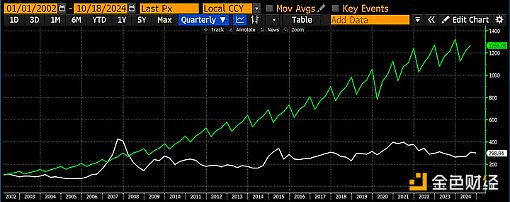
With the index at 100, China GDP (green) +1200% vs. CSI300 Index (white) +200%.
Since the stock market really started to develop in the early 2000s, the stock market has lagged far behind the crazy growth of the Chinese economy (as shown in the above chart). The average Chinese is not stupid, so stocks are not the first method to increase savings. Instead, they turn to the real estate market.
The key to re-establishing China's (Zhongguo, literally means "Middle Kingdom") global dominance can only be achieved through global manufacturing strength. This means getting farmers off the farm and into the city to make goods for export. Hence, every five-year plan has an urbanization target.
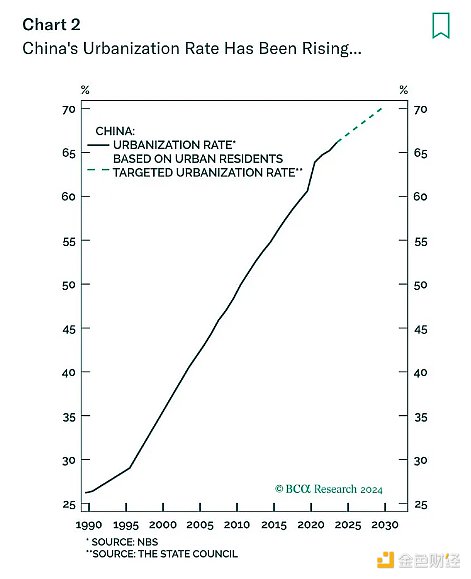
If hundreds of millions of people are to be moved from rural areas to cities in just a few decades, a large amount of residential and industrial real estate will need to be built. The first way to make money in real estate is to sell land to developers. Local governments own their own land and sell it to developers through leasing rights. Since the central government keeps most of the income tax revenue for itself, local governments mainly raise funds by selling land. As urbanization and economic growth advance, land becomes more valuable and sales revenue surges. The central government also sets quotas on how much debt local governments can issue each year. Usually, this debt is collateralized by their land reserves. Therefore, the government's finances are directly linked to rising housing prices.
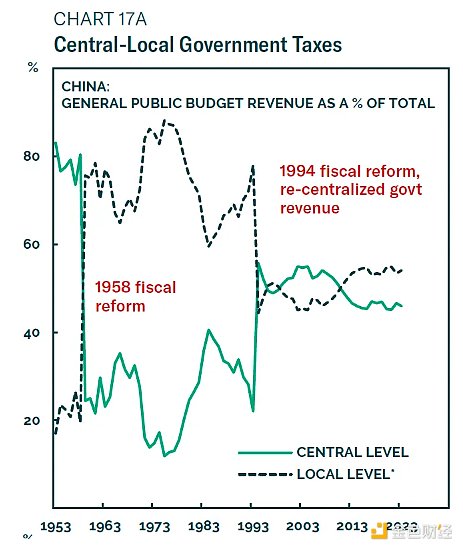

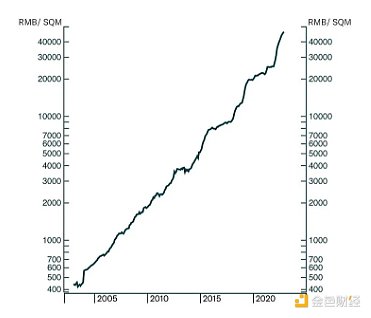
Land prices have increased 80-fold over 19 years, a compound annual growth rate of 26%.
The average person gets rich by saving and then buying one or more apartments. From the early 1990s to 2020, real estate prices have only gone up. Banks, which typically do not offer any type of consumer credit, are more than happy to lend against real estate. The average household’s net worth is almost entirely tied to rising real estate prices.
As housing prices rise, all stakeholders make money. After satisfying the initial demand of a rapidly urbanizing population, the market continues to build apartment units because it is encouraged and the only place banks feel they can safely extend credit. What ensued was an unprecedented real estate bubble.
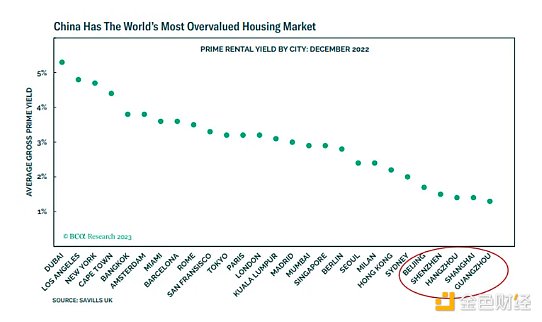
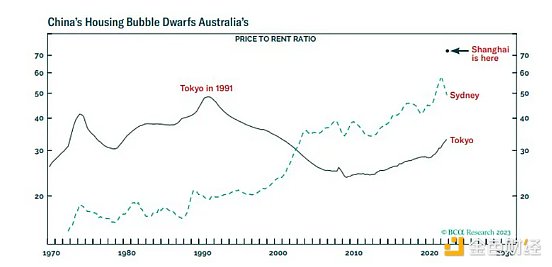
When the vast majority of comrades cannot afford housing, the social structure will be broken. The falling birth rate is a symptom of the real estate bubble disease. Young people are poor, but given the high real estate prices, the only house they can afford is a rubber house. In addition, too much bank credit flows into real estate instead of funding new technology development. The state redirected funds from unproductive, speculative real estate development to high-tech manufacturing.
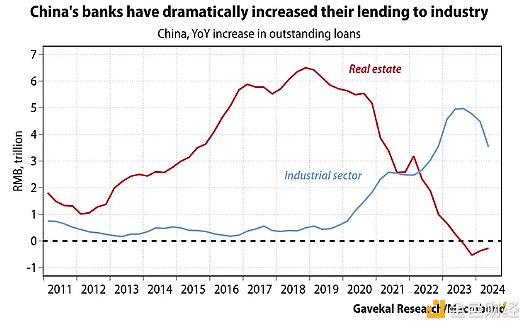 In the mid-2010s, China began talking tough about controlling the real estate market, but in reality, the bursting of the bubble came with a series of risks. Every large state-owned bank and industrial enterprise has a huge exposure to the real estate market. A large part of the assets in the bank's loan book are residential property loans issued to households or developers. One of the largest end-customer groups for companies that produce goods such as air conditioners, steel, and cement is real estate developers. In addition, the central government continues to keep most of the tax revenue for itself so that the central government's balance sheet looks strong, which means that local governments will not be able to achieve their stipulated growth targets if land prices do not continue to rise. Puncturing the real estate bubble will destroy ordinary households, banks, industrial enterprises, and local governments. If control of the market is lost on the downside, social harmony could be destroyed.
In the mid-2010s, China began talking tough about controlling the real estate market, but in reality, the bursting of the bubble came with a series of risks. Every large state-owned bank and industrial enterprise has a huge exposure to the real estate market. A large part of the assets in the bank's loan book are residential property loans issued to households or developers. One of the largest end-customer groups for companies that produce goods such as air conditioners, steel, and cement is real estate developers. In addition, the central government continues to keep most of the tax revenue for itself so that the central government's balance sheet looks strong, which means that local governments will not be able to achieve their stipulated growth targets if land prices do not continue to rise. Puncturing the real estate bubble will destroy ordinary households, banks, industrial enterprises, and local governments. If control of the market is lost on the downside, social harmony could be destroyed.
By 2020, the state saw fit to end rampant real estate speculation and all its harmful effects. Then the three red lines policy was introduced. Soon, the most leveraged real estate developers stopped building and completing homes and defaulted on overseas bonds. Evergrande Group is a high-profile example of a Chinese real estate developer that went bankrupt after its access to credit was restricted.
Before continuing with the timeline of this story, I want to quickly touch on a lesser-known quirk of the Chinese real estate market and its implications for what types of policy measures will successfully end the crisis. In China, most apartments are pre-sale. You have to pay a cash deposit up front and then pay the balance after obtaining a mortgage several years before the property is completed. In essence, the real estate developers are operators of a Ponzi scheme. The full payment for the units that have not yet been delivered will be used to pay for the completion of the older units. The real estate developers also use this pre-sale cash as collateral to obtain bank credit, as they still need more funds to complete older, vintage projects and purchase land from local governments for new construction.
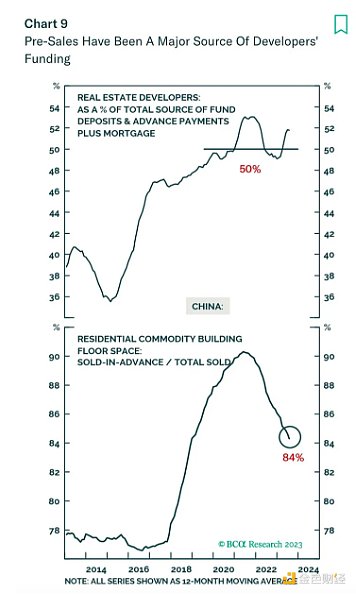

When banks were asked to slow lending to debt-ridden developers, doubts arose as to whether buyers would receive unfinished homes. If ordinary Chinese families do not trust that real estate developers will complete the construction of houses, they will not buy pre-sale houses. Without pre-sale funds, real estate developers cannot complete the construction of old houses. The end result is that developers have to stop building, confidence in the entire real estate market structure collapses, and everyone loses.
The Chinese government responded early in the crisis by instructing banks and local governments to lend to real estate developers so they could complete construction. However, there is a huge agency problem here. While the central government has supreme power on paper, they rely on officials to risk their careers to carry out their orders.
Imagine that you run a local government. If you drive economic growth, you get promoted, but if you lose money, you get investigated. Investigations often pop up years after the alleged behavior occurred. So there is no benefit in taking risks, and even if the central government tells you to lend, there is nothing you can do. The central government continues to issue higher quotas, allowing real estate developers to obtain more credit, but these credits are not dispersed. Another option is for the government - both central and local - to participate in construction and complete millions of unfinished houses to restore market confidence. They haven’t done so yet, and I imagine it’s because such a task is too complex for a top-down central government to handle, given the millions of square feet of housing that need to be completed.
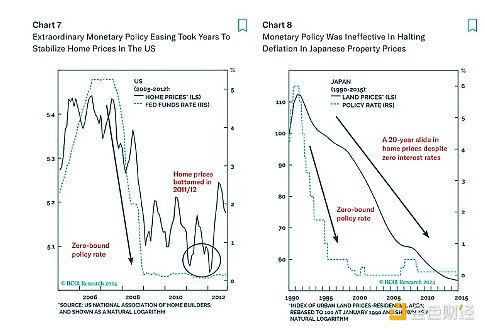 Which brings us to the current moment. Using traditional monetary policy, it could take decades to drive prices down and restore confidence.
Which brings us to the current moment. Using traditional monetary policy, it could take decades to drive prices down and restore confidence.
Since China’s economy is slowing rapidly, it’s time to call in the witch doctors.
Reflation
Let’s look through some depressing charts to understand the impact of the bursting of the housing bubble on the Chinese economy.
Listening to economists’ pessimistic comments about the Chinese economy, you might think that Beijing has been sitting on the sidelines and doing nothing. But that’s not the case.
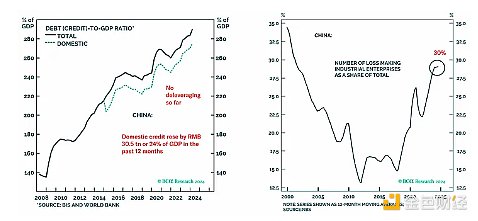
The absolute amount of fiscal and monetary stimulus is huge. But with the economy suffering from severe overcapacity, the money is just enough to keep things going. This is evidenced by the rising debt-to-GDP ratio (left), which has allowed zombie state-owned enterprises to stay afloat (right) and avoid large-scale layoffs.
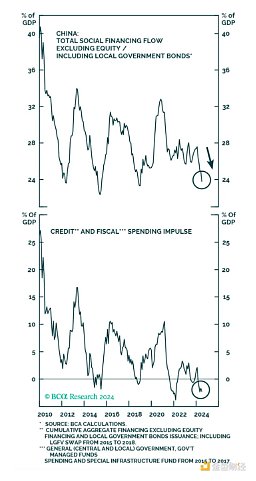 But when you have just burst the largest real estate bubble in human history, you need chemotherapy to stop deflation. Everything is relative, and relative to the scale of the economic black hole torn by the real estate market collapse, the current measures are not enough to generate a positive credit and/or fiscal spending impulse. Even with all this stimulus, loan demand remains at historic lows. That’s because real interest rates are still too high.
But when you have just burst the largest real estate bubble in human history, you need chemotherapy to stop deflation. Everything is relative, and relative to the scale of the economic black hole torn by the real estate market collapse, the current measures are not enough to generate a positive credit and/or fiscal spending impulse. Even with all this stimulus, loan demand remains at historic lows. That’s because real interest rates are still too high.
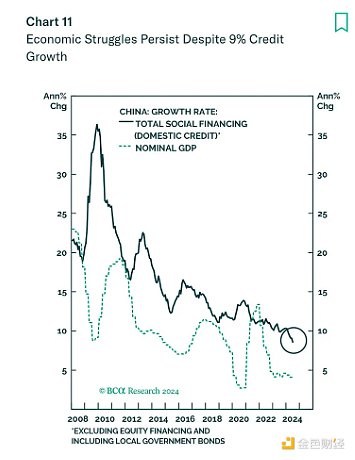 China's broad money growth is at a historic low, and nominal GDP growth has slowed sharply.
China's broad money growth is at a historic low, and nominal GDP growth has slowed sharply.
When economic activity shrinks as deflation clears excess capacity, the real problem facing the central government is a group of young, educated, unemployed, property-less, and unattractive men.
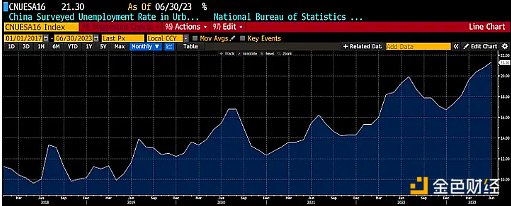 If China were the US or the EU, it would go to war with another country and put these young people through the wartime meat grinder. But large-scale foreign military adventures are not in China's genes. China needs to get economic activity moving again by implementing quantitative easing and increasing broad money growth so that ordinary college-educated students can find jobs.
If China were the US or the EU, it would go to war with another country and put these young people through the wartime meat grinder. But large-scale foreign military adventures are not in China's genes. China needs to get economic activity moving again by implementing quantitative easing and increasing broad money growth so that ordinary college-educated students can find jobs.
This summer the People's Bank of China (PBOC) updated its toolkit so that it can start conducting open market operations in the government bond market.
We will gradually incorporate secondary market bond trading into our toolkit. The market has recently paid more attention to this, and is also constantly enriching and improving the way of base money injection. In the past, it was passively injected through foreign exchange reserves. After 2014, the amount of foreign exchange reserves decreased, and base money was actively injected through open market operations, MLF and other tools.
It should be noted that the inclusion of treasury bond trading in the monetary policy toolbox does not mean quantitative easing, but as a channel for base money injection and liquidity management tool, treasury bond trading (including treasury bond trading) will work together with other tools to create a good liquidity environment.
China's current monetary policy stance and the evolution of the future monetary policy framework
Today, quantitative easing is such a dirty word because ordinary people know it means inflation, which is a bad news bear market. Whatever the People's Bank of China wants to call it, starting in August this year, they increased their holdings of local government bonds from 1.5 trillion yuan to 4.6 trillion yuan. This is the first time the People's Bank of China has printed money to buy government bonds since 2007.
The only way for China to increase fiscal stimulus to the level needed to escape the deflation trap is to issue a large number of local and central government bonds. Even though Chinese bond yields are at all-time lows, they are still too restrictive from a practical standpoint. The price of money needs to fall to zero and the money supply must increase dramatically. This can only happen if the People’s Bank of China implements quantitative easing.
The Fed, the European Central Bank (ECB), and the Bank of Japan (BOJ) all started quantitative easing by buying small amounts of government bonds. But they eventually got religious and printed large amounts of money to escape their deflationary traps. China and the People’s Bank of China will do the same. Don’t let the initial modest intervention fool you – the People’s Bank of China will eventually print tens of trillions of RMB to right-size the Chinese economy.
Quantitative easing is coming to China, but it’s only half the battle. Banks need to lend again to drive high nominal GDP growth.
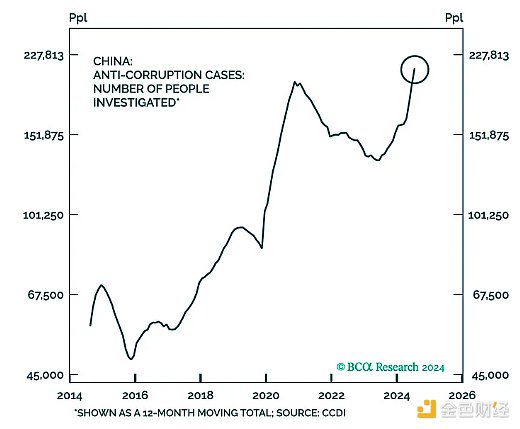 Let’s go back to the motivations of the executives at the state banks. They don’t want to make a lot of new loans, some of which will inevitably go bad, and be investigated for corruption a few years later. They need to know that the central government has their back.
Let’s go back to the motivations of the executives at the state banks. They don’t want to make a lot of new loans, some of which will inevitably go bad, and be investigated for corruption a few years later. They need to know that the central government has their back.
One sign that the PBOC will encourage bank credit growth is that in a recent series of monetary policy measures, the Chinese government announced that it would borrow money and inject that capital directly into the banking system. Given that all banks are owned by the state, borrowing money from the left hand to the right hand is a bit theoretical. But I think it is entirely cosmetic. The central government is signaling through its actions that bank managers will not face personal risk if they increase loan growth.
In a recent communique, the central government will forgive mistakes made by lower-level officials for actions taken to improve the economy. By removing the risk of personal greed, officials can start lending, and the amount of money they lend is enough to drive the economy forward.
The financial indicators of Chinese banks when it comes to non-performing loans (NPLs) look a bit messy. According to the Bank for International Settlements, after the real estate crisis, the NPLs of the banking system reached an average of about 22%. Chinese banks report an NPL rate of only 2%. Are Chinese banks special? I think not. There is a reason why Chinese banks only want to lend to projects that are directly supported by the government. From a crypto perspective, imagine a bank whose loan book only includes loans to FTX, Three Arrows Capital, BlockFi, Genesis, and Voyager. If this bank reports the lowest NPL rate of all banks, would you still believe them after learning that all the companies it lent money to went bankrupt? To revive the animal spirits of the banking industry, the central government needs to repair bank balance sheets through capital injections.
Another policy that tells me that the central government is ready to open up the banks to allow them to extend credit widely is the cap on total compensation for bankers. Due to recent government orders, I believe the maximum total compensation for financial services employees is $420,000, whether they work for a state-owned enterprise or a private bank. When the United States bailed out its banking industry, no such limit was imposed; JPMorgan Chase CEO Jamie Dimon made $17.6 million after his bank was bailed out by the government in 2009. The central government knows that inflation is extremely profitable for the banking system, especially if the government is essentially backing all lending. They also know that wealth will not trickle down, which has caused anger among the common people.
The central government is quietly telling the market that it is injecting itself with monetary chemotherapy. You just have to listen. Many analysts believe that one side effect is a depreciation of the renminbi against the dollar.
Renminbi
Russell Napier has written an excellent article explaining why he thinks China is ready and willing to inject itself with the monetary policy I described in the previous section. He also believes that China will tolerate a depreciation of the renminbi because of the sharp increase in the supply of renminbi. I don't know if I believe that the central government is willing to let the renminbi depreciate much, because it will trigger capital flight. But I don't think the renminbi will depreciate that much against the dollar. Therefore, this prediction will not be tested.
We all know that China is the world's factory. Therefore, China's trade surplus continues to hit record highs. But if you look at the data carefully, you will find that China's trade surplus (exports minus imports) has increased not because exports have increased, but because the import intensity of China's economy is decreasing, and China is able to pay for a larger proportion of its imports in renminbi rather than dollars.
To illustrate my hypothesis, suppose that China initially exports a total of $100 per month and imports a total of $50; that is, a trade surplus of $50. Now, the import intensity of its export economy has decreased - for example, China used to need to buy auto parts from abroad, but now most parts are produced domestically. The trade surplus will increase even if the volume of exported goods has not increased. To achieve the same $100 worth of exports, only $25 of imports are needed. Therefore, the surplus rises to $75. The second way the surplus could go up is if the same amount of imports were made but now half of the imports were paid for in RMB. This would also reduce the imports to $25 and increase the surplus to $75.
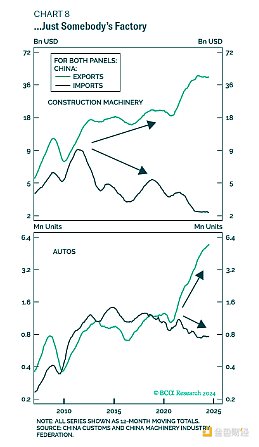
The chart above illustrates how China can export more construction machinery and cars by importing fewer goods.
The commodity China lacks most is energy, but now China can buy goods from countries like Saudi Arabia and Russia with RMB instead of dollars.
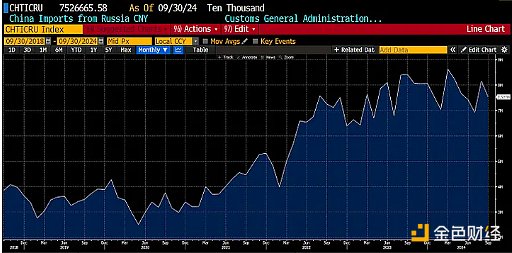 Before the West stole Russia’s USD/EUR and imposed sanctions after the outbreak of the war in Ukraine in February 2022, China could not dictate the terms of trade. But now Russia has no choice but to pay in RMB as required and supply China with energy at a discount.
Before the West stole Russia’s USD/EUR and imposed sanctions after the outbreak of the war in Ukraine in February 2022, China could not dictate the terms of trade. But now Russia has no choice but to pay in RMB as required and supply China with energy at a discount.
As China increases its domestic RMB supply, which in turn boosts economic growth, inflation will inevitably rise. However, given that China is producing more goods domestically and paying a higher proportion of its energy bills in RMB, rising inflation will not cause the RMB to depreciate significantly against the US dollar, as it did in the past.
The final reason why the RMB will not depreciate significantly is that while China is reflationary, the US will pursue a weak dollar industrial policy regardless of who wins the presidential election. I know Trump and Harris are trying to draw attention to their differences, but in essence, they are both going to print money and distribute it to key industrial sectors in the United States.
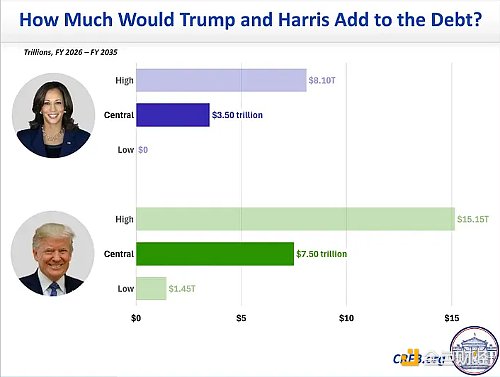
I don’t necessarily agree that Harris will spend less than Trump, but regardless, whoever wins, we are talking about trillions of dollars of additional fiat money supply entering the market over the next few years. This will certainly lead to a structurally weak dollar.
China will not feel the negative side effects of its domestic currency when pursuing this reflationary policy. The signs of China printing a lot of RMB are very clear. What is the antidote for the civilians who will witness an increase in credit creation (which is not necessarily dependent on the strengthening of the real economy)? Bitcoin!
Let's Go Bitcoin
The Chinese are one of the most resourceful people on earth. They won't let their precious RMB savings sit idle at a time when the central government is encouraging asset prices to rise. Bitcoin is not a foreign concept to residents of middle- and high-income coastal cities. Although exchanges are prohibited from offering visible Bitcoin/RMB trading pairs, Bitcoin and cryptocurrencies are still booming in China.
The market has returned to its peer-to-peer (P2P) roots. In the past, when the three major Chinese exchanges (OKCoin now OKX, Huobi and Bitcoin China) dominated, funding exchange accounts with RMB was always a challenge. Sometimes users could directly transfer funds from their domestic Chinese bank accounts, and sometimes they had to go through a complicated voucher scheme. Regardless, the Chinese found ways to transfer RMB from their local bank accounts to exchanges for trading.
Today, I hear that China has a vibrant P2P market again. All major Asian spot exchanges, such as Binance, OKX and Bybit, are doing big business on the mainland. These exchanges operate P2P message boards where local traders help people trade cryptocurrencies. It’s like a Chinese version of LocalBitcoins. The point is, it’s relatively simple for an aspiring Chinese to exchange RMB for cryptocurrencies.
The reason China shut down the Bitcoin/RMB trading pair (and I’m just speculating here) is probably because they don’t want a smoke alarm to appear, exposing the impact of their currency devaluation plans. Such an alarm might motivate investors to choose Bitcoin as a store of value over stocks or real estate. Given that the Chinese government knows it can’t ban Bitcoin, and Bitcoin and cryptocurrency ownership is not banned in China (contrary to claims by some misleading financial media), the central government would rather keep it out of sight and mind. Therefore, if my prediction is correct, I won’t have a clear statistic that can clearly track the flow of RMB into the Bitcoin ecosystem. Other than the green cross, I can only know that changes are happening through word of mouth.
There will definitely be no inflows into Hong Kong-listed Bitcoin exchange-traded funds (ETFs). If funds flow into the Hong Kong market through the Stock Connect, they won’t be used to buy domestic stocks or real estate. This is why mainlanders will be banned from buying Hong Kong Bitcoin ETFs. Condolences to all the issuers who paid expensive advertising fees in Hong Kong subway stations - the central bank won't make it that easy for people to get their hands on Bitcoin.
While I don't have inflow charts of domestically listed Bitcoin tracking products or Bitcoin/CNY price quotes to review, I know that stocks and real estate have underperformed the growth of the central bank's balance sheet.
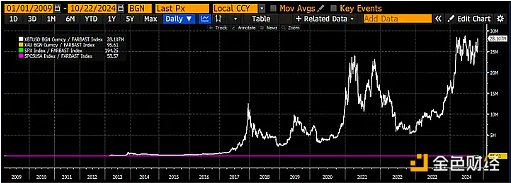 Here's a chart of Bitcoin (white), Gold (gold), the S&P 500 (green), and the Case-Shiller U.S. Real Estate Price Index (magenta), all divided by the Fed's Balance Sheet Index of 100. Bitcoin has outperformed all other risk assets to the point where you can't even distinguish the returns of other assets on the right axis.
Here's a chart of Bitcoin (white), Gold (gold), the S&P 500 (green), and the Case-Shiller U.S. Real Estate Price Index (magenta), all divided by the Fed's Balance Sheet Index of 100. Bitcoin has outperformed all other risk assets to the point where you can't even distinguish the returns of other assets on the right axis.
As you can tell, this is my favorite chart. No major risk asset class has fared better in a currency debasement than Bitcoin. Investors know this instinctively, and when you think about how to protect the purchasing power of your savings, Bitcoin stares you in the face like a Kwisatz Haderach.
For those who thought the market would immediately recognize the future and push Bitcoin accordingly, I’m sorry to disappoint you. It will take time for the PBOC’s quantitative easing and bank credit growth to accelerate again. It will take time for chemotherapy to kill the patient. In these initial stages, Chinese savers reacted as I would expect: by buying oversold domestic stocks and deeply discounted apartments.
The pessimism of economists so far about the size and scale of the stimulus package presents a perfect opportunity to buy. Because when ordinary wealthy people in coastal areas decide that they must hold Bitcoin no matter what the price of the RMB does, the upward movement in the price of Bitcoin will be back to August 2015, when Bitcoin rose from $135 to $600 after the PBOC suddenly devalued the RMB - an almost 5x increase in price in less than 3 months.
 Catherine
Catherine



 As can be seen, the prime lending rate is always lower than industrial value added. This is because the deposit interest rates paid by state-owned banks to ordinary savers are negligible - see the figure below.
As can be seen, the prime lending rate is always lower than industrial value added. This is because the deposit interest rates paid by state-owned banks to ordinary savers are negligible - see the figure below.  Depositors know they are being treated unfairly, but because the RMB is a restricted currency, depositors cannot invest overseas. To get a better return on their capital, they can invest in local stocks or the property market.
Depositors know they are being treated unfairly, but because the RMB is a restricted currency, depositors cannot invest overseas. To get a better return on their capital, they can invest in local stocks or the property market. 
 Private enterprises that participate in real competition earn higher returns than state-owned enterprises. However, state-owned enterprises are more represented in major stock market indices.
Private enterprises that participate in real competition earn higher returns than state-owned enterprises. However, state-owned enterprises are more represented in major stock market indices. 






 In the mid-2010s, China began talking tough about controlling the real estate market, but in reality, the bursting of the bubble came with a series of risks. Every large state-owned bank and industrial enterprise has a huge exposure to the real estate market. A large part of the assets in the bank's loan book are residential property loans issued to households or developers. One of the largest end-customer groups for companies that produce goods such as air conditioners, steel, and cement is real estate developers. In addition, the central government continues to keep most of the tax revenue for itself so that the central government's balance sheet looks strong, which means that local governments will not be able to achieve their stipulated growth targets if land prices do not continue to rise. Puncturing the real estate bubble will destroy ordinary households, banks, industrial enterprises, and local governments. If control of the market is lost on the downside, social harmony could be destroyed.
In the mid-2010s, China began talking tough about controlling the real estate market, but in reality, the bursting of the bubble came with a series of risks. Every large state-owned bank and industrial enterprise has a huge exposure to the real estate market. A large part of the assets in the bank's loan book are residential property loans issued to households or developers. One of the largest end-customer groups for companies that produce goods such as air conditioners, steel, and cement is real estate developers. In addition, the central government continues to keep most of the tax revenue for itself so that the central government's balance sheet looks strong, which means that local governments will not be able to achieve their stipulated growth targets if land prices do not continue to rise. Puncturing the real estate bubble will destroy ordinary households, banks, industrial enterprises, and local governments. If control of the market is lost on the downside, social harmony could be destroyed.

 Which brings us to the current moment. Using traditional monetary policy, it could take decades to drive prices down and restore confidence.
Which brings us to the current moment. Using traditional monetary policy, it could take decades to drive prices down and restore confidence.
 But when you have just burst the largest real estate bubble in human history, you need chemotherapy to stop deflation. Everything is relative, and relative to the scale of the economic black hole torn by the real estate market collapse, the current measures are not enough to generate a positive credit and/or fiscal spending impulse. Even with all this stimulus, loan demand remains at historic lows. That’s because real interest rates are still too high.
But when you have just burst the largest real estate bubble in human history, you need chemotherapy to stop deflation. Everything is relative, and relative to the scale of the economic black hole torn by the real estate market collapse, the current measures are not enough to generate a positive credit and/or fiscal spending impulse. Even with all this stimulus, loan demand remains at historic lows. That’s because real interest rates are still too high.  China's broad money growth is at a historic low, and nominal GDP growth has slowed sharply.
China's broad money growth is at a historic low, and nominal GDP growth has slowed sharply.  If China were the US or the EU, it would go to war with another country and put these young people through the wartime meat grinder. But large-scale foreign military adventures are not in China's genes. China needs to get economic activity moving again by implementing quantitative easing and increasing broad money growth so that ordinary college-educated students can find jobs.
If China were the US or the EU, it would go to war with another country and put these young people through the wartime meat grinder. But large-scale foreign military adventures are not in China's genes. China needs to get economic activity moving again by implementing quantitative easing and increasing broad money growth so that ordinary college-educated students can find jobs.  Let’s go back to the motivations of the executives at the state banks. They don’t want to make a lot of new loans, some of which will inevitably go bad, and be investigated for corruption a few years later. They need to know that the central government has their back.
Let’s go back to the motivations of the executives at the state banks. They don’t want to make a lot of new loans, some of which will inevitably go bad, and be investigated for corruption a few years later. They need to know that the central government has their back.
 Before the West stole Russia’s USD/EUR and imposed sanctions after the outbreak of the war in Ukraine in February 2022, China could not dictate the terms of trade. But now Russia has no choice but to pay in RMB as required and supply China with energy at a discount.
Before the West stole Russia’s USD/EUR and imposed sanctions after the outbreak of the war in Ukraine in February 2022, China could not dictate the terms of trade. But now Russia has no choice but to pay in RMB as required and supply China with energy at a discount.
 Here's a chart of Bitcoin (white), Gold (gold), the S&P 500 (green), and the Case-Shiller U.S. Real Estate Price Index (magenta), all divided by the Fed's Balance Sheet Index of 100. Bitcoin has outperformed all other risk assets to the point where you can't even distinguish the returns of other assets on the right axis.
Here's a chart of Bitcoin (white), Gold (gold), the S&P 500 (green), and the Case-Shiller U.S. Real Estate Price Index (magenta), all divided by the Fed's Balance Sheet Index of 100. Bitcoin has outperformed all other risk assets to the point where you can't even distinguish the returns of other assets on the right axis.



